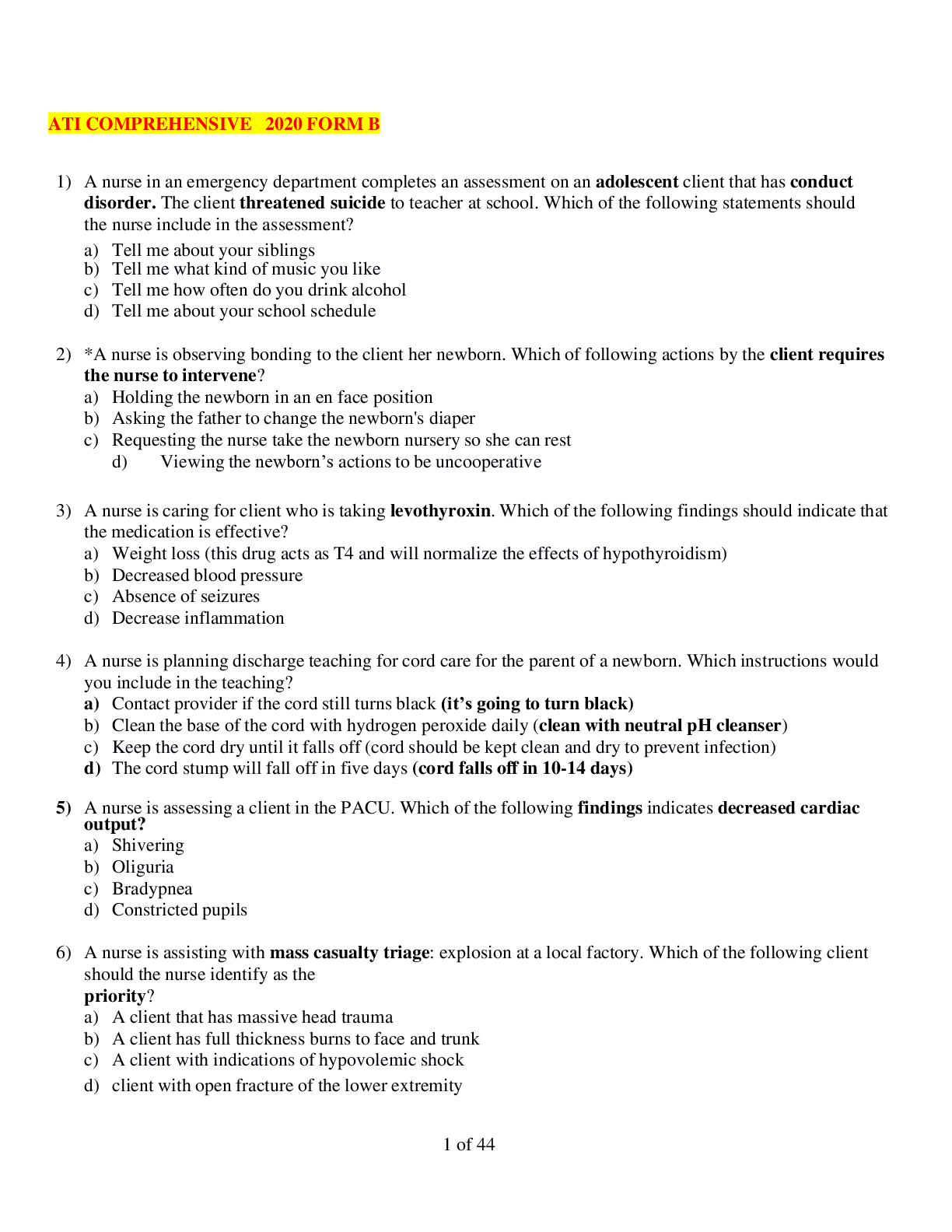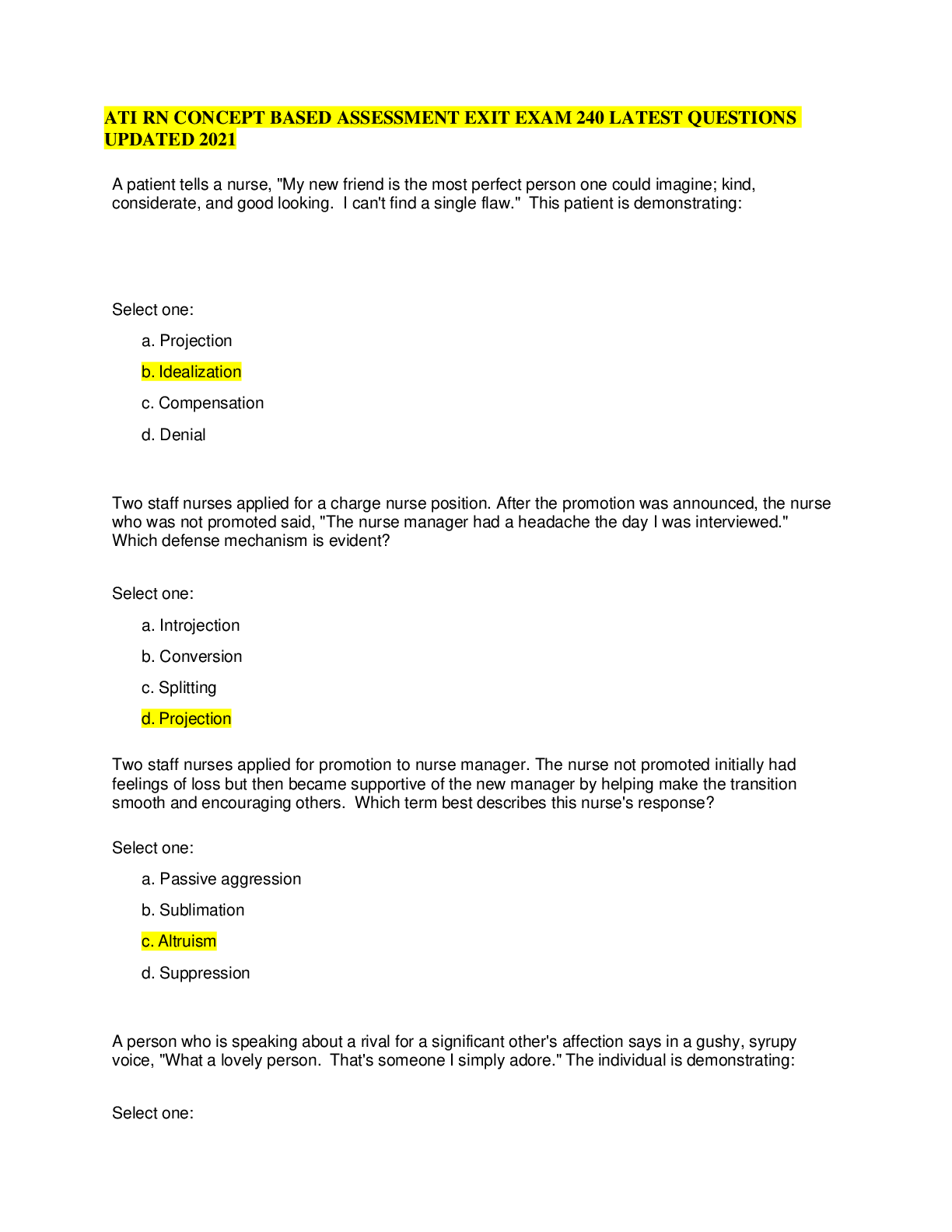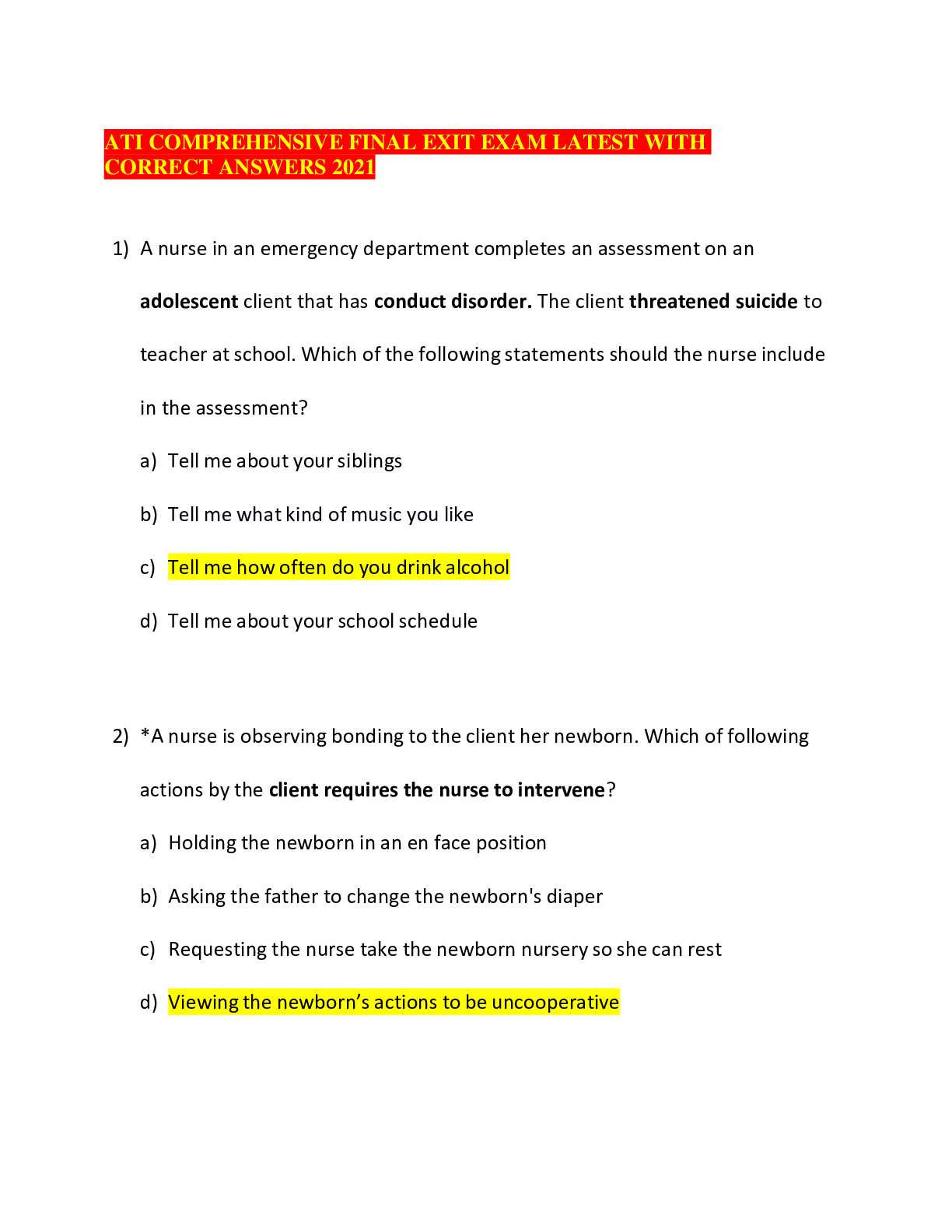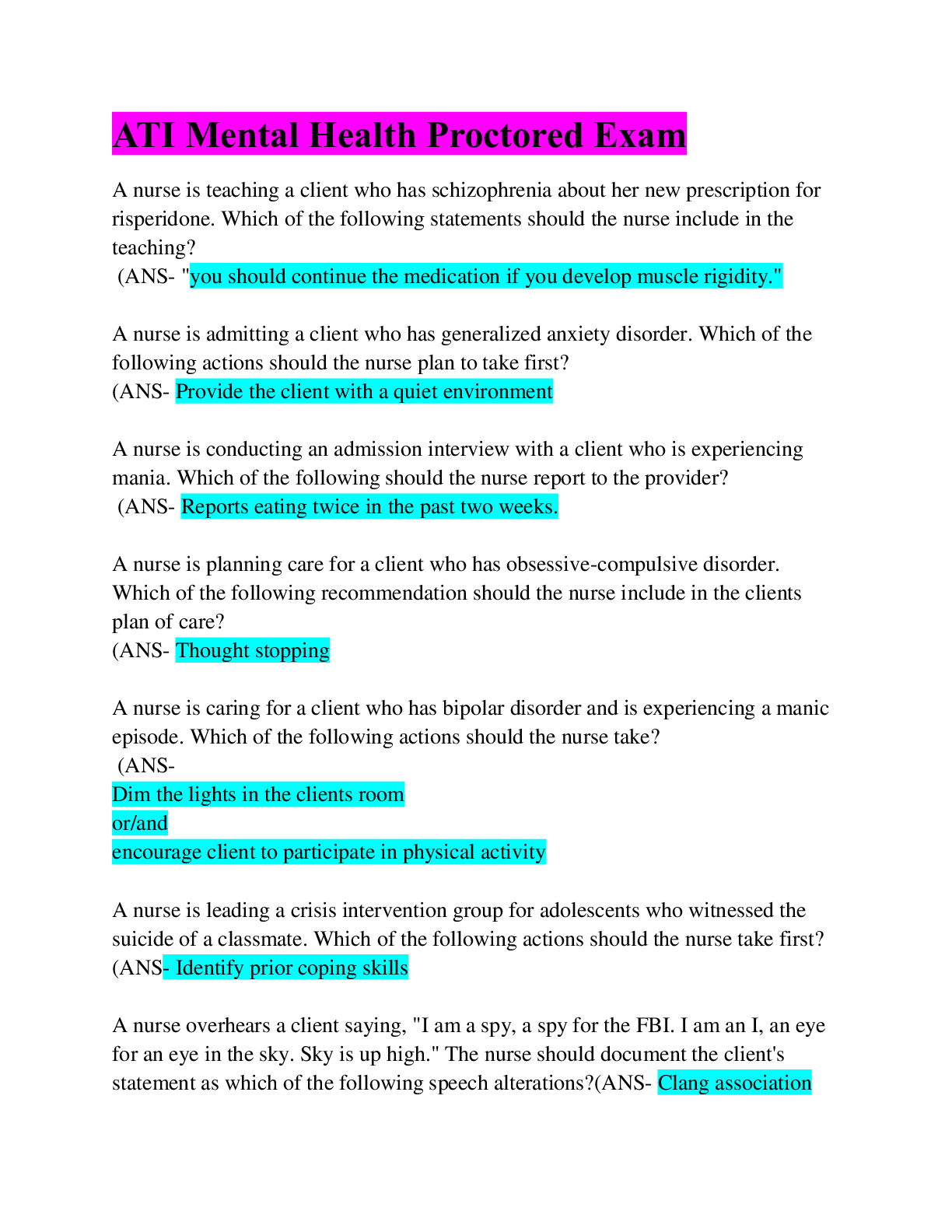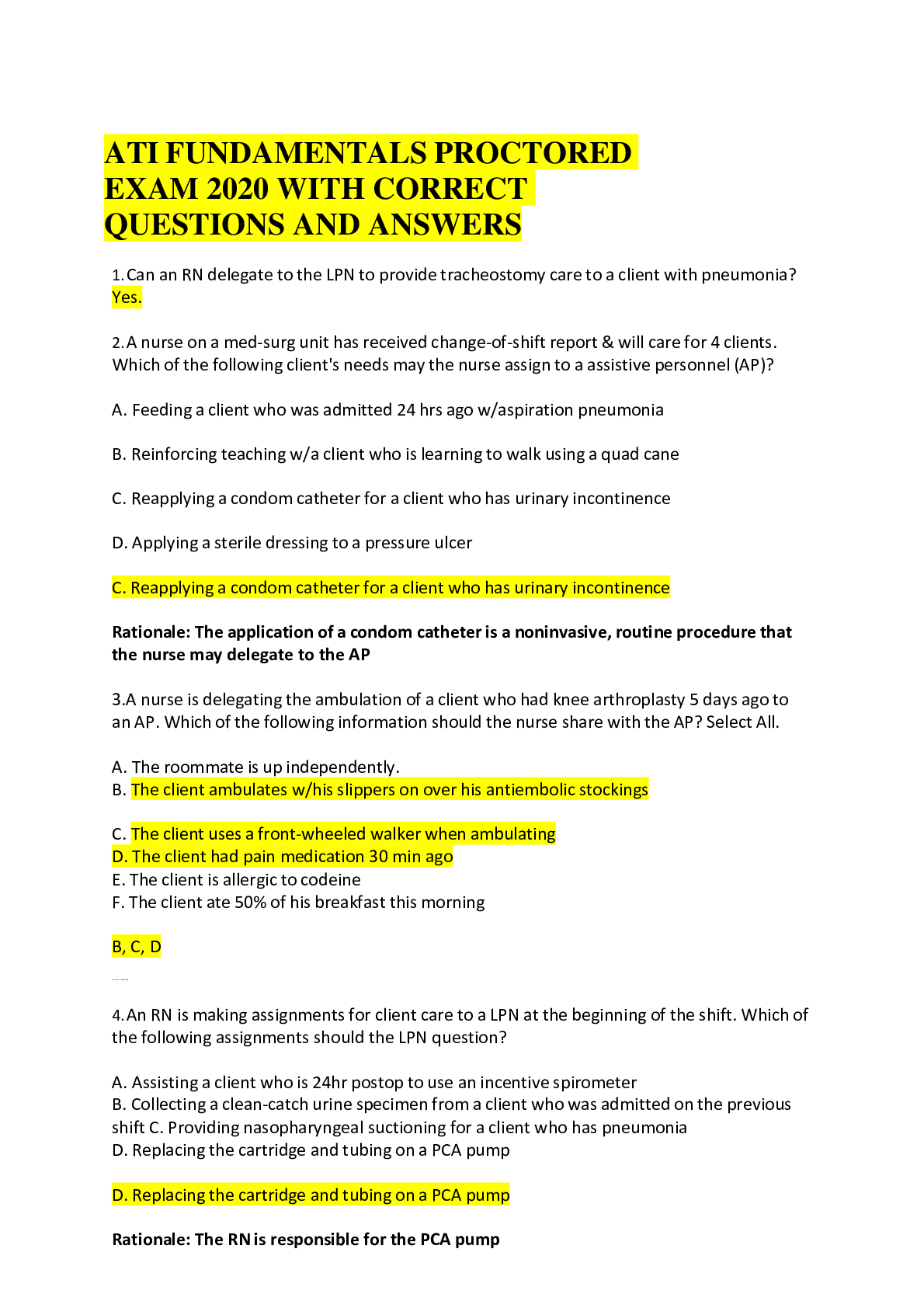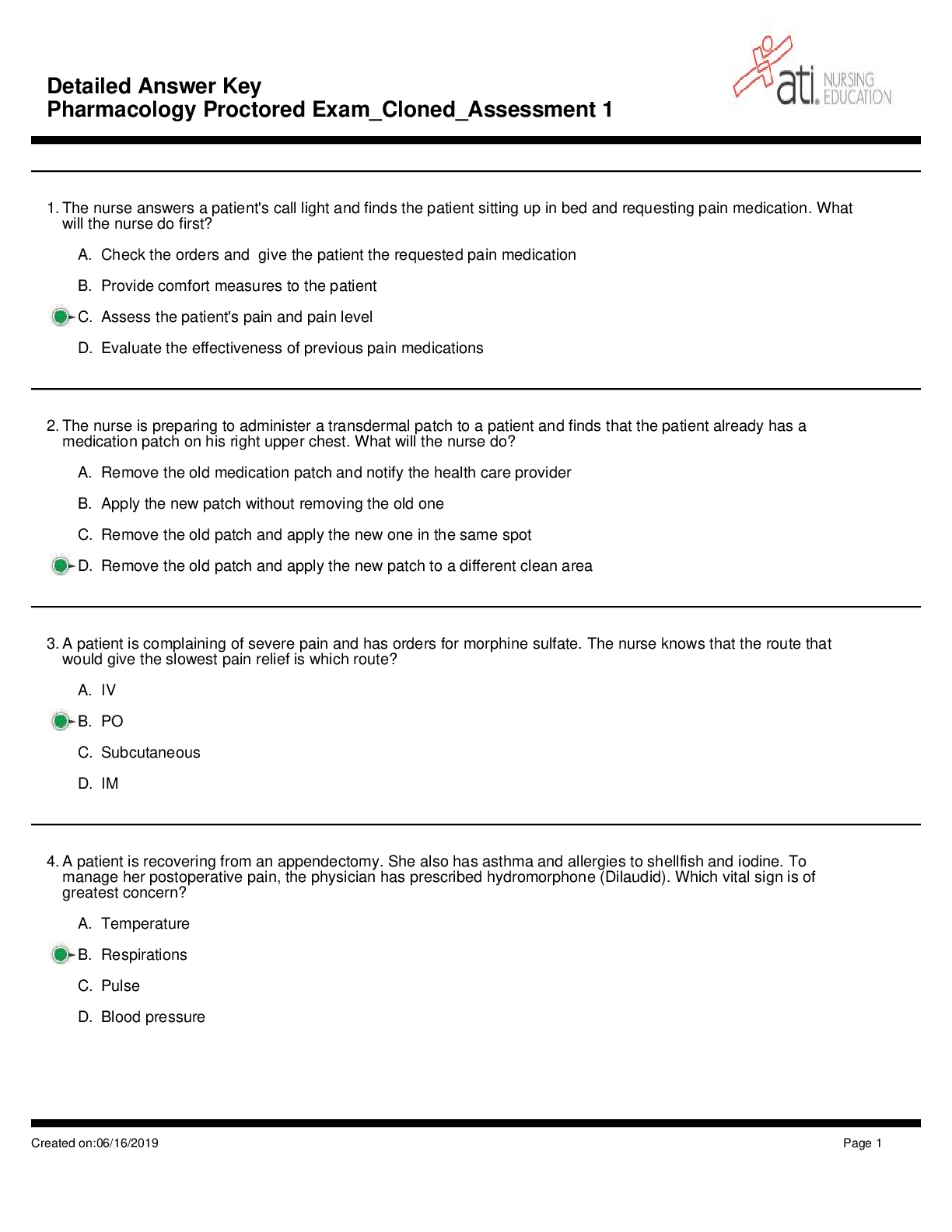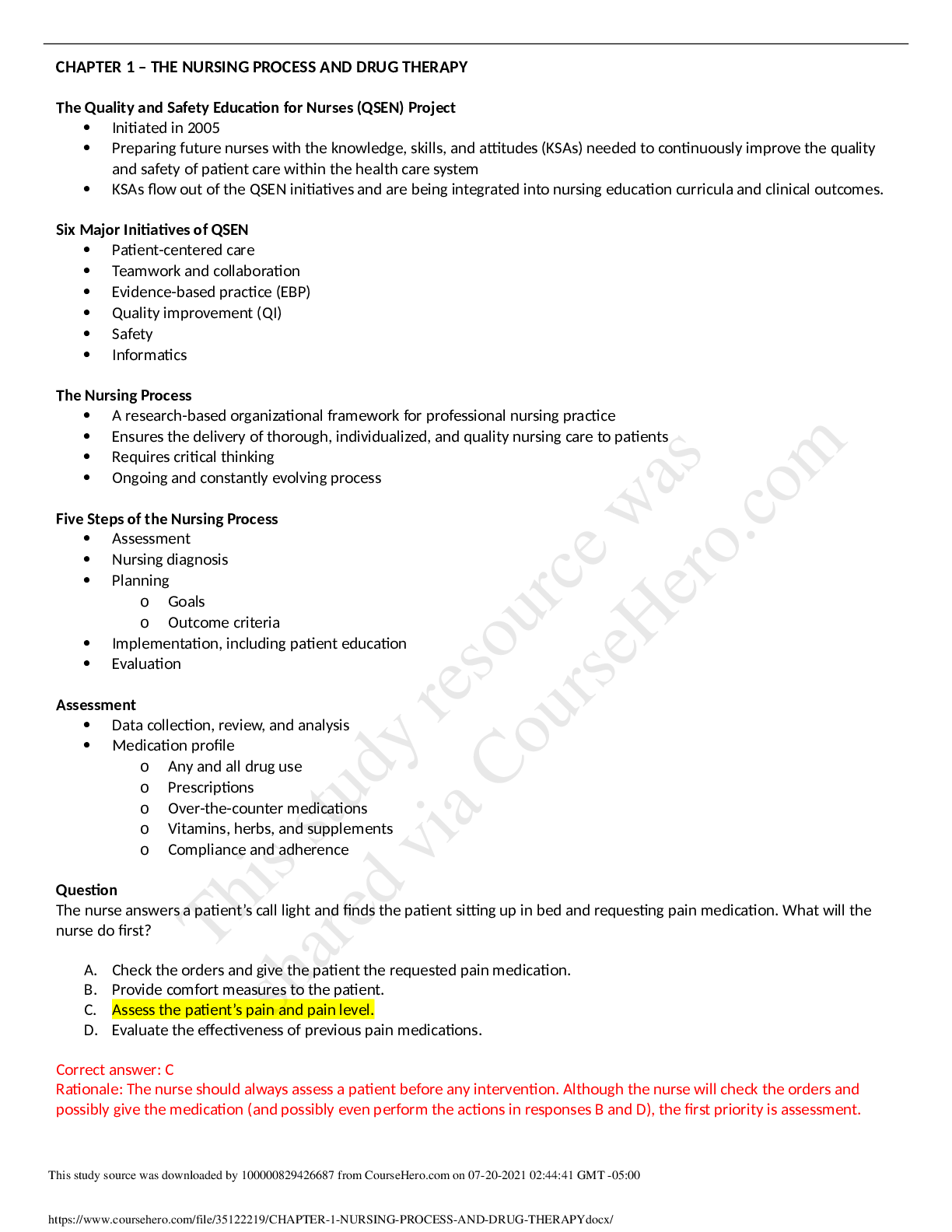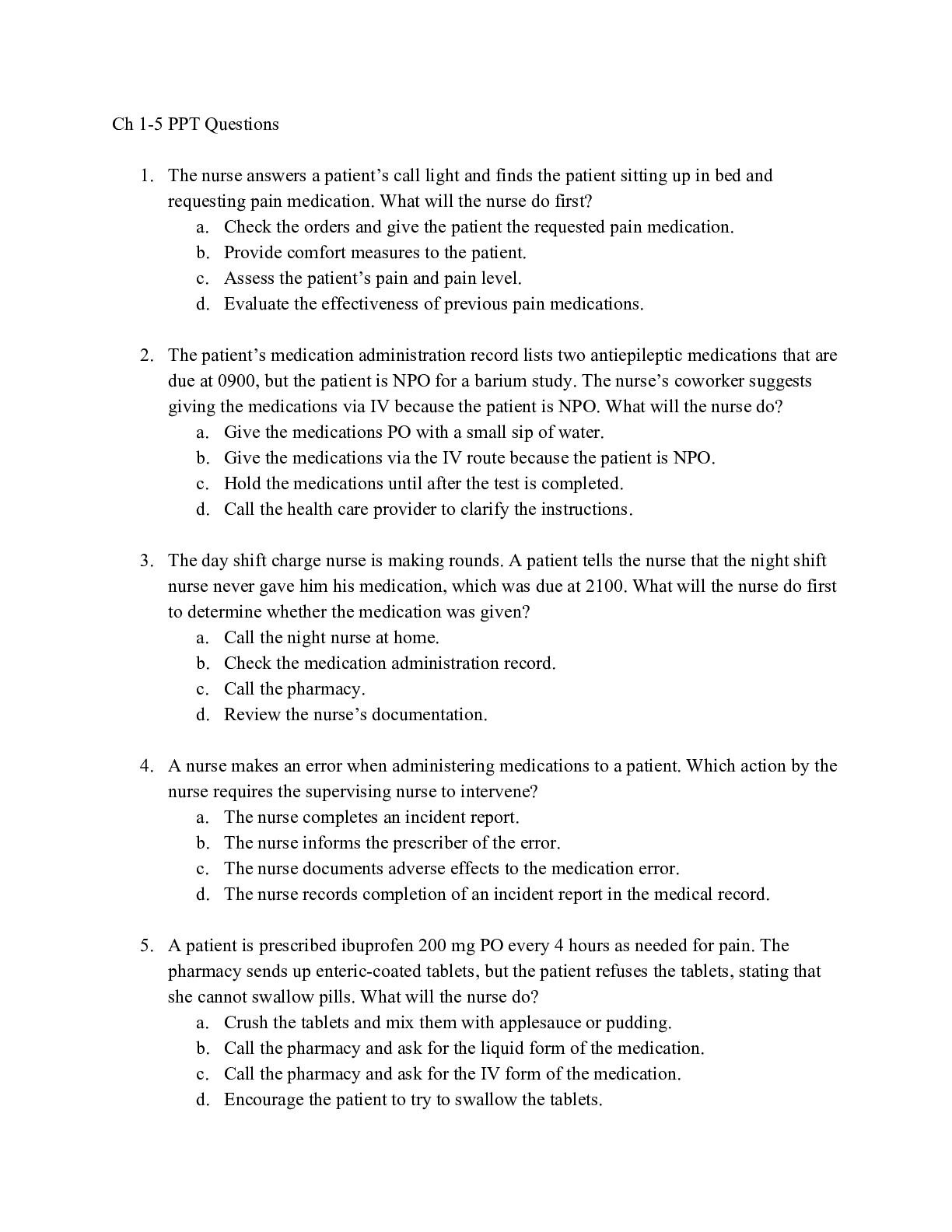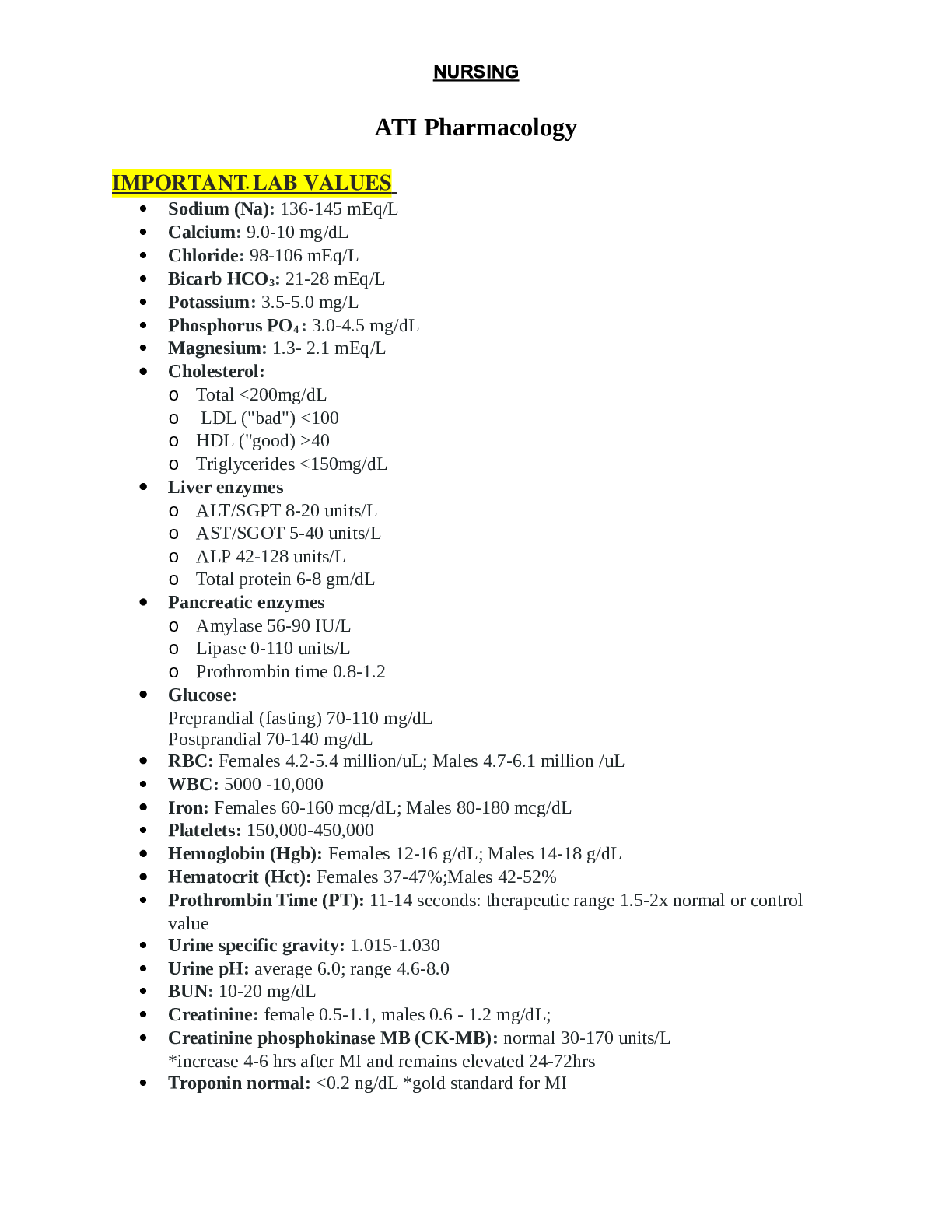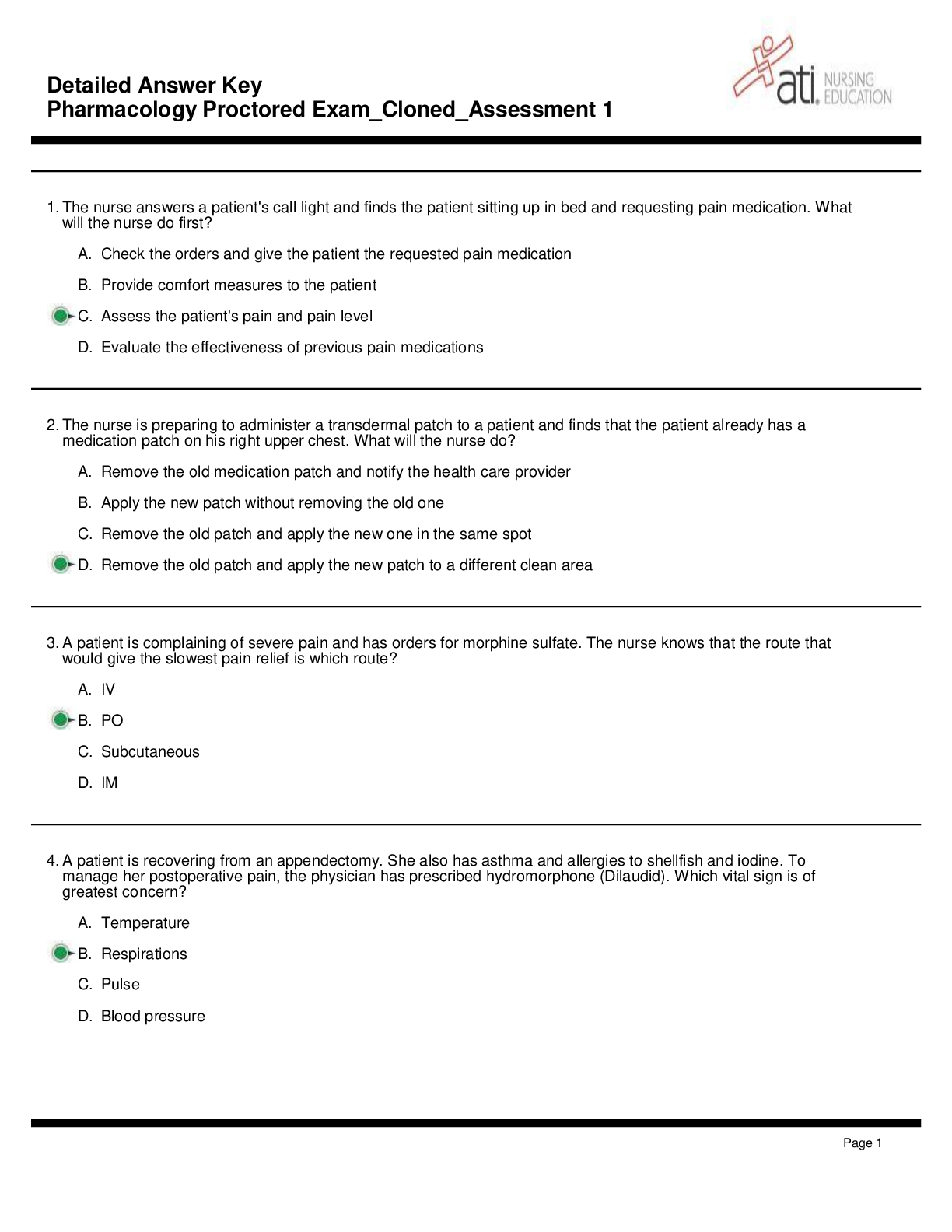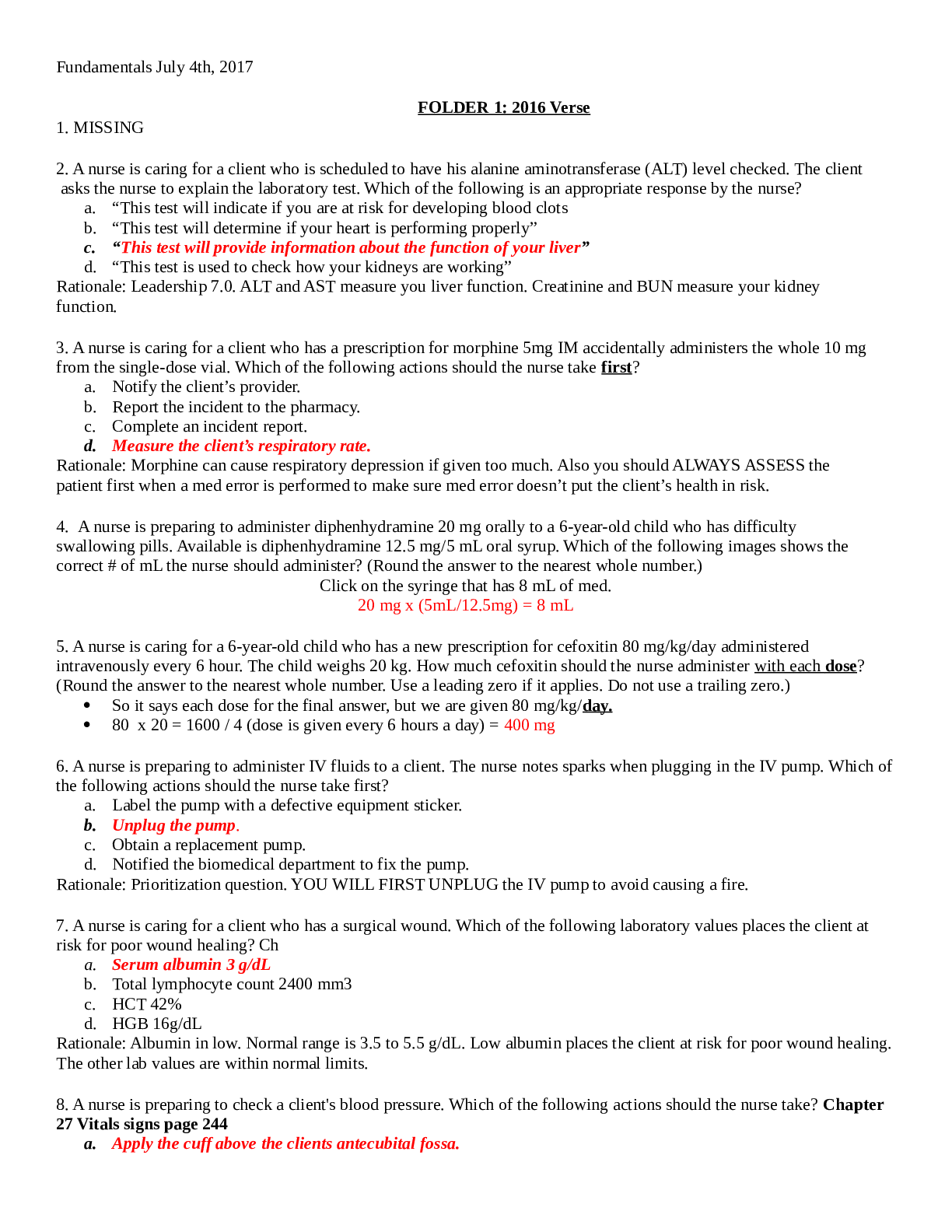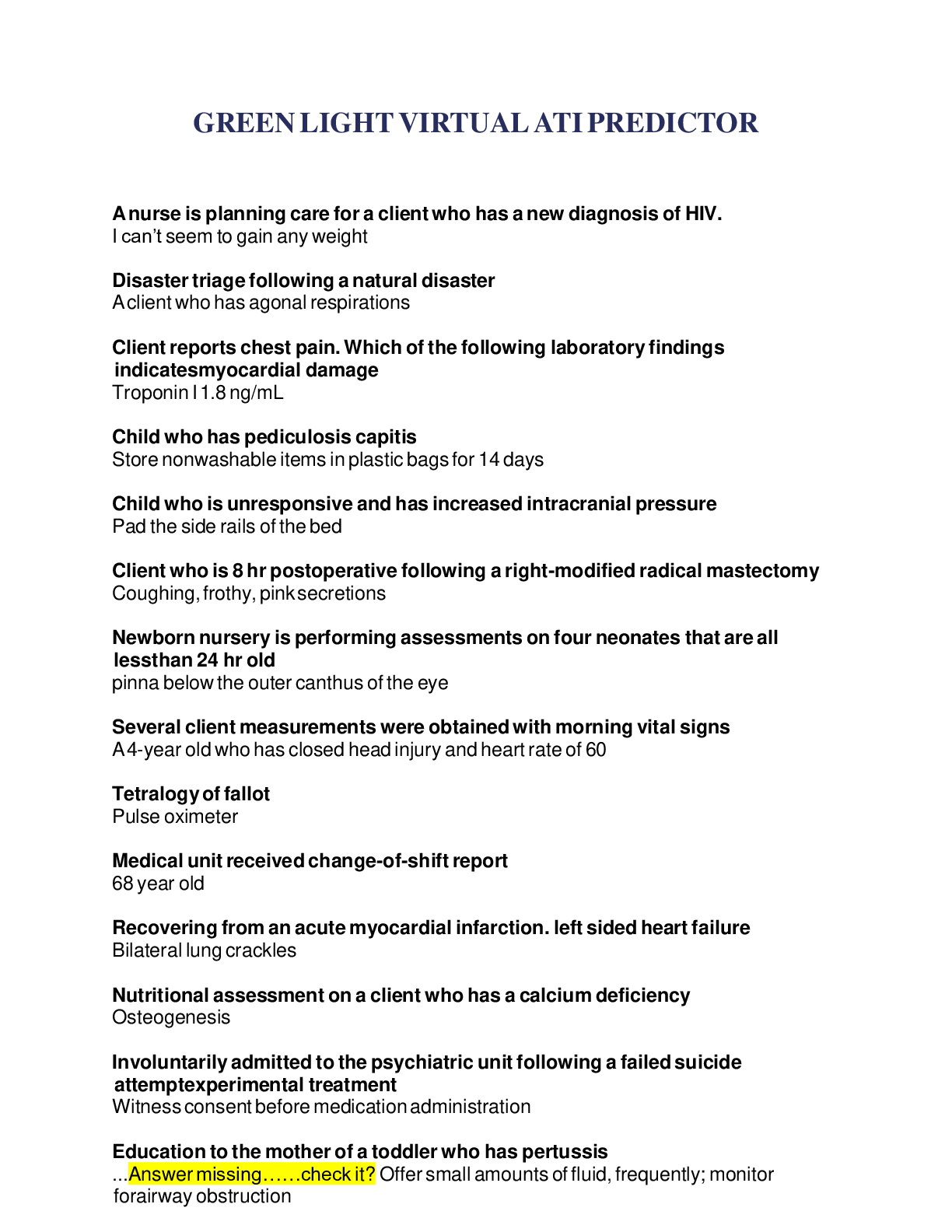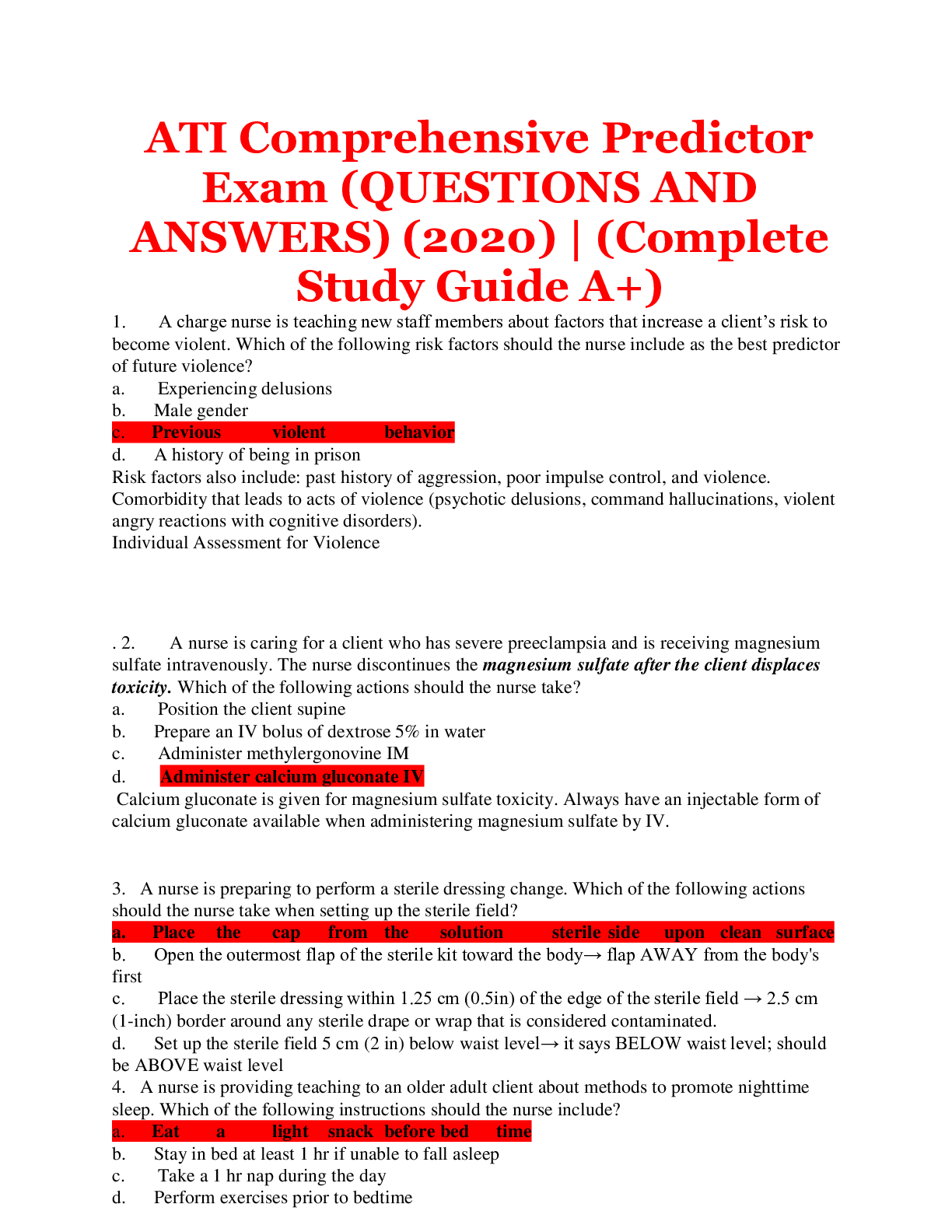*NURSING > QUESTIONS and ANSWERS > PHARMACOLOGY ATI PROCTORED EXAM DETAILED ANSWER KEY CLONED ASSESSMENT CONTAINS 100 QUSTIONS AND ANSW (All)
PHARMACOLOGY ATI PROCTORED EXAM DETAILED ANSWER KEY CLONED ASSESSMENT CONTAINS 100 QUSTIONS AND ANSWERS CORRECT ANSWERS HIGHLIGHTED
Document Content and Description Below
1. The nurse answers a patient’s call light and finds the patient sitting up in bed and requesting pain medication. What will the nurse do first? A. Check the orders and give the patient the reques... ted pain medication. B. Provide comfort measures to the patient. C. Assess the patient’s pain and pain level. D. Evaluate the effectiveness of previous pain medications. 2. The patient’s medication administration record lists two antiepileptic medications that are due at 0900, but the patient is NPO for a barium study. The nurse’s coworker suggests giving the medications via IV because the patient is NPO. What will the nurse do? A. Give the medications PO with a small sip of water. B. Give the medications via the IV route because the patient is NPO. C. Hold the medications until after the test is completed. D. Call the health care provider to clarify the instructions. 3. The day shift charge nurse is making rounds. A patient tells the nurse that the night shift nurse never gave him his medication, which was due at 2100. What will the nurse do first to determine whether the medication was given? A. Call the night nurse at home. B. Check the medication administration record. C. Call the pharmacy. D. Review the nurse’s notes. 4. A nurse makes an error when administering medications to a patient. Which action by the nurse requires the supervising nurse to intervene? The nurse A. completes an incident report. B. informs the prescriber of the error. C. documents adverse effects to the medication error. D. records completion of an incident report in the medical chart. Chapter 2 1. A patient is prescribed ibuprofen 200 mg PO every 4 hours as needed for pain. The pharmacy sends up enteric-coated tablets, but the patient refuses the tablets, stating that she cannot swallow pills. What will the nurse do? A. Crush the tablets and mix them with applesauce or pudding. B. Call the pharmacy and ask for the liquid form of the medication. C. Call the pharmacy and ask for the IV form of the medication. D. Encourage the patient to try to swallow the tablets. 2. The nurse is preparing to administer a transdermal patch to a patient and finds that the patient already has a medication patch on his right upper chest. What will the nurse do? A. Remove the old medication patch and notify the health care provider. B. Apply the new patch without removing the old one. C. Remove the old patch and apply the new patch in the same spot. D. Remove the old patch and apply the new patch to a different, clean area. 3. The nurse is giving a medication that has a high first-pass effect. The health care provider has changed the route from IV to PO. The nurse expects the oral dose to be A. higher because of the first-pass effect. B. lower because of the first-pass effect. C. the same as the IV dose. D. unchanged. 4. A patient is complaining of severe pain and has orders for morphine sulfate. The nurse knows that the route that would give the slowest pain relief would be which route? A. IV B. IM C. Subcutaneous D. PO Chapter 3 1. When teaching a pregnant woman about the use of drugs during pregnancy, which statement will the nurse include? A. Exposure of the fetus to drugs is most detrimental during the second trimester of pregnancy. B. Pregnant women must never take drugs to control high blood pressure. C. Drug transfer to a fetus is most likely to occur during the last trimester of pregnancy. D. A fetus is at greatest risk for drug-induced developmental defects during the second trimester of pregnancy. 2. When administering medications to pediatric patients, the nurse understands that the dosage calculations for pediatric patients are different than for adults because pediatric patients A. are more likely to develop edema. B. have more stomach acid. C. have skin that is less permeable. D. have immature liver and kidney function, resulting in impaired drug metabolism and excretion. 3. What does the nurse identify as a pharmacokinetic change that occurs in older adults? A. Gastric pH is more acidic. B. Fat content is decreased because of increased lean body mass. C. There is increased production of proteins by the liver. D. The number of intact nephrons is decreased. Chapter 4. 1. Which racial group is predicted to be nearly one in three U.S. residents in 2050? A. African American B. Asian C. Hispanic D. White 2. Which of the following statements regarding African Americans’ responses to antihypertensive medication therapy is true? A. African Americans respond better to diuretics than to beta blockers. B. African Americans do not respond to diltiazem. C. Single-drug therapy is effective for African Americans. D. Hypertension is uncommon in the African-American population. 3. A research group is conducting an investigational drug study on a promising new drug for osteoporosis. It has been difficult to find research participants who meet the criteria. Just before the conclusion of the study, four participants approach the researchers and express their desire to withdraw from the study. The researcher should first A. inform them that they waited too long to withdraw from the study. B. explore with them the reasons for withdrawing from the study. C. acknowledge that they can withdraw at any time from the study. D. request that they try to remain with the study until it is completed. 4. A nurse does not notice that a patient’s IV site is swollen, red, painful, and warm to touch nor that the IV has quit infusing properly. This is an example of A. breach of duty. B. duty. C. causation. D. damage. 5. A nurse has been asked to participate in an elective procedure that violates the nurse’s personal ethical principles. The nurse should A. refuse to participate. B. ask to switch assignments with another nurse. C. speak to the manager or supervisor. D. perform the procedure. Chapter 5 1. In a 2006 IOM study, it was estimated that some form of medication error resulted in harm to how many patients? A. 400,000 B. 800,000 C. 1 million D. 1.5 million 2. The nurse is administering a drug that has been ordered as follows: “Give 10 mg on odd- numbered days and 5 mg on even-numbered days.” When the date changes from May 31 to June 1, what should the nurse do? A. Give 10 mg because June 1 is an odd-numbered day. B. Hold the dose until the next odd-numbered day. C. Change the order to read: “Give 10 mg on even-numbered days and 5 mg on odd- numbered days.” D. Consult the prescriber to verify that the dose should alternate each day, no matter whether the day is odd or even numbered 3. The nursing student realizes that she has given a patient a double dose of an antihypertensive medication. The tablet was supposed to be cut in half, but the student forgot and administered the entire tablet. The patient’s blood pressure just before the dose was 146/98 mm Hg. What should the student nurse do first? A. Notify the patient’s physician. B. Notify the clinical faculty. C. Take the patient’s blood pressure. D. Continue to monitor the patient. Chapter 6 1. The nurse is caring for an 85-year-old patient in the hospital and teaching him how to use an inhaler. His 84-year-old wife attends the teaching sessions, and their daughter comes in to visit in the evenings. The patient is having trouble remembering the steps. The nurse should A. provide the package insert that comes with the medication for the patient to read. B. focus the teaching sessions on the patient’s wife. C. provide small amounts of information at a time, repeating information frequently. D. wait until the daughter comes in and teach the daughter instead. 2. A patient with newly diagnosed type 1 diabetes mellitus has completed a diabetes education program. One month later, the patient confesses at a follow-up appointment that he “just didn’t feel like” giving himself the insulin injections. Which nursing diagnosis will the nurse assign the patient? A. Deficient knowledge B. Noncompliance C. Impaired memory D. Sleep deprivation 3. A nurse is providing patient teaching for a community health center that serves a primarily Portuguese population. The nurse would best serve this patient population by A. learning Portuguese. B. always using interpreter services. C. using the family member interpreter the patient provides. D. finding a job in a different setting. 4. After providing education regarding medications to a patient who has been newly diagnosed with type 2 diabetes mellitus, the nurse would use which part of the nursing process to assess whether the patient understands these new instructions? A. Assessment B. Diagnosis C. Implementation D. Evaluation Chapter 7 1. OTC medications now account for about what percent of all medications used in the United States? A. 5% B. 15% C. 30% D. 60% 2. A 56-year-old man is taking OTC antacids for relief of indigestion. He tells the nurse that he consumes at least one bottle a week and has done so for more than 1 month because “it works for me.” The nurse’s main concern is that A. this self-treatment is expensive. B. this self-treatment may be delaying treatment of a more serious problem. C. this self-treatment may be the best treatment of his indigestion. D. the long-term use of antacids may make the indigestion worse. 3. The nurse associates use of which OTC medication with the development of hepatotoxicity? A. Acetylsalicylic acid (aspirin) B. Ibuprofen (Motrin) C. Pseudoephedrine (Sudafed) D. Acetaminophen (Tylenol) 4. A patient tells the nurse that he wants to stop taking his antilipemic drugs and start taking garlic to lower his cholesterol. The nurse’s best reply would be: A. “That decision is up to you.” B. “You have every right to switch to herbal remedies.” C. “You should not go against what the doctor has prescribed for you.” D. “Let’s explore the evidence that supports the use of garlic to lower your cholesterol.” Chapter 38 1. A patient is receiving Augmentin (amoxicillin and clavulanic acid) liquid solution through a percutaneous endoscopic gastrostomy tube. What is the purpose of the clavulanic acid? A. It works synergistically with the antibiotic to improve potency. B. It inhibits the action of the enzymes produced by beta-lactamase–producing bacteria. C. It protects the antibiotic from the harmful gastric acid secretions in the stomach. D. It enhances the absorption of the antibiotic in the small intestine. 2. Which of the following does the nurse identify as being a concern for patients receiving tetracycline? A. Tetracycline should not be administered to anyone older than age 65 years. B. Tetracycline has no impact on the effectiveness of oral contraceptives. C. Tetracycline used with warfarin decreases its effectiveness and enhances clot formation. D. Tetracyclines should not be administered with dairy products. 3. When completing an admission assessment, the patient states that she is allergic to sulfa drugs. What will the nurse do next? A. Mark the allergy on her medical record. B. Place an “allergy” armband on the patient. C. Ask the patient for more information about the allergic reaction she had. D. Notify the physician about the patient’s allergy. 4. A patient has a prescription for a sulfa drug as treatment for a UTI. She is also taking an oral contraceptive, an oral sulfonylurea antidiabetic drug, and phenytoin for a history of seizures. Which drug may pose a potential serious interaction with the sulfa drug? A. The oral contraceptive B. The oral antidiabetic drug C. The phenytoin D. All of these 5. The nurse identifies Zosyn as being a member of which group? A. Cephalosporins B. Macrolides C. Penicillins D. Sulfonamides Chapter 39 1. During intravenous (IV) quinolone therapy in an 88-year-old patient, which potential problem is of most concern when assessing for adverse effects? A. Hepatotoxicity B. Rhabdomyolysis C. Tendon rupture D. Nephrotoxicity 2. A patient is prescribed linezolid (Zyvox) to treat hospital-acquired pneumonia. It is most important for the nurse to determine if the patient is also taking which medication? A. A diuretic B. An SSRI C. A cardiac glycoside D. A thyroid replacement drug 3. A 58-year-old man is receiving vancomycin as part of the treatment for a severe bone infection. After the infusion, he begins to experience some itching and flushing of the neck, face, and upper body. He reports no chills or difficulty breathing. The nurse should suspect A. an allergic reaction has occurred. B. an anaphylactic reaction is about to occur. C. the medication will not be effective for the bone infection. D. the IV dose may have infused too quickly. 4. A group of office workers is concerned because a package was opened that contained a white powder substance. There is a concern that the white powder is anthrax. Which drug does the nurse anticipate being prescribed for the office workers? A. daptomycin (Cubicin) B. colistimethate (Coly-Mycin) C. ciprofloxacin (Cipro) D. quinupristin–dalfopristin (Synercid) [Show More]
Last updated: 1 year ago
Preview 1 out of 8 pages
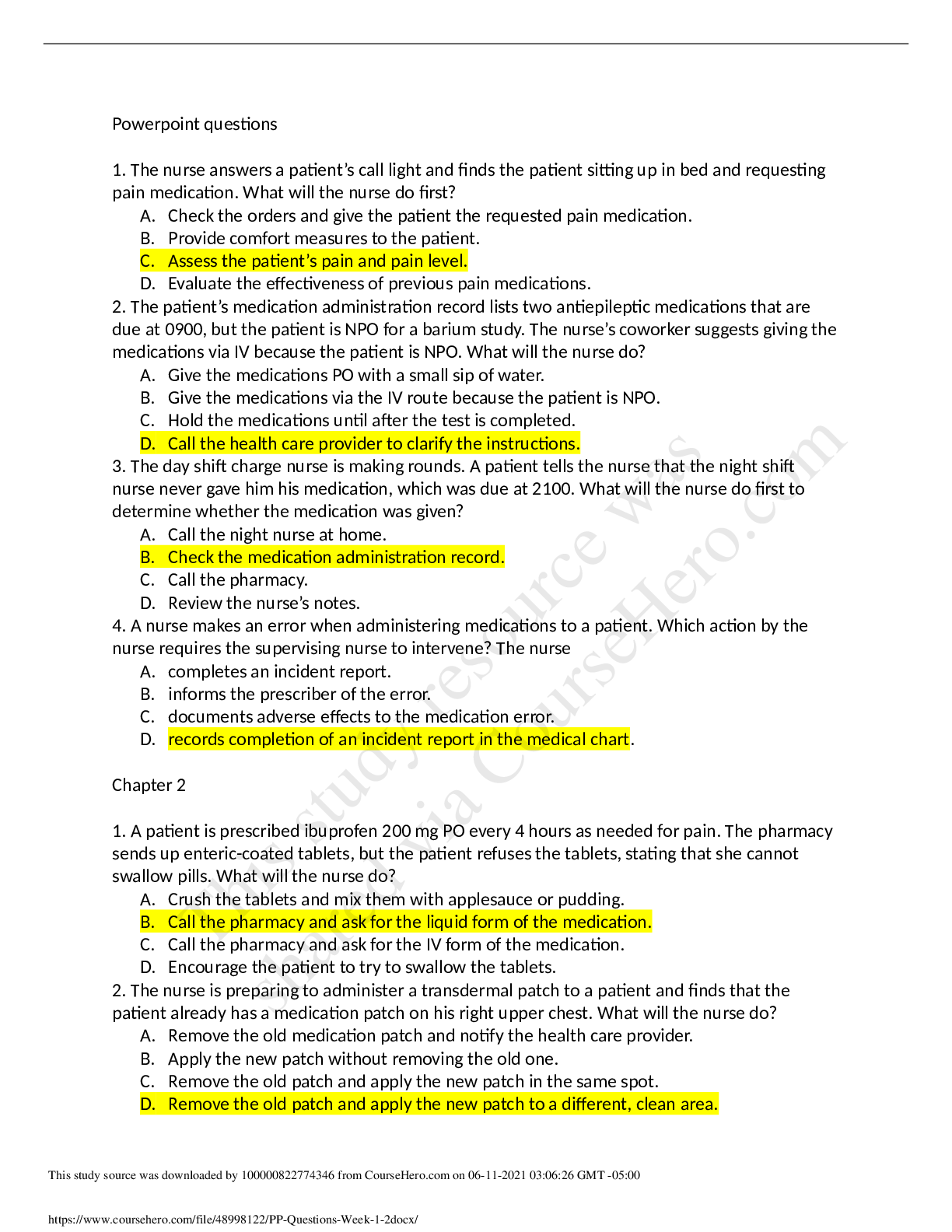
Reviews( 0 )
Document information
Connected school, study & course
About the document
Uploaded On
Jun 11, 2021
Number of pages
8
Written in
Additional information
This document has been written for:
Uploaded
Jun 11, 2021
Downloads
0
Views
49

